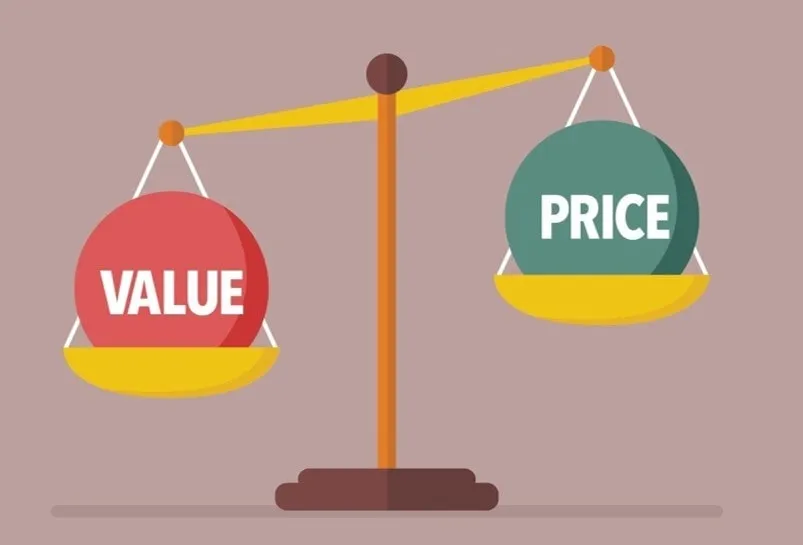Still pricing based on cost? You might be leaving money on the table. Value pricing flips the traditional pricing model where you focus on what customers will pay not just what it costs. This isn’t a trend – it’s a proven approach used by top businesses to increase profits by up to 25% (McKinsey & Company).
More companies are moving to value-based pricing because it justifies premium pricing, attracts loyal customers and increases revenue without price wars. In a world where customers demand more for their money, understanding and implementing value pricing is key.
This guide will show you why businesses are adopting value pricing, how it works, and how to do it – so you can set the right price, and make more money.
What is Value Pricing?

Value pricing is a strategy where businesses set prices based on how much customers are willing to pay, rather than just production costs. It focuses on perceived value rather than cost-based pricing or competition-based pricing.
Why Businesses Are Shifting to Value-Based Pricing
A strong value-based strategy allows companies to build long-term customer loyalty while maintaining premium pricing. Below are a few more reasons:
1. Maximizing Profits with Customer-Driven Pricing
With value-based pricing, companies price products according to customer demand. If customers see high value, they are willing to pay more. Brands and companies like Apple and Tesla use this strategy to set premium price points while keeping customers loyal.
2. Competing Beyond Just Price
Many businesses struggle in price wars, cutting costs to attract buyers. Value pricing means competing on quality, innovation, and customer experience, not just the lowest price. This helps businesses stay profitable even in crowded markets.
3. Justifying Premium & Luxury Pricing
Customers don’t just buy a product—they buy an experience. Luxury brands like Rolex or Louis Vuitton use value-based pricing models to justify higher price tags by focusing on exclusivity, brand perception, and customer loyalty.
4. Encouraging Innovation & Better Product Development
When businesses charge based on value added pricing, they focus on creating better products, not just producing cheaper ones. This leads to high-quality services, stronger customer segments, and improved customer perceptions.
5. Avoiding the Pitfalls of Cost-Based Pricing
Cost-plus pricing ignores customer perceptions and market demand. It may result in overpricing or underpricing, leading to lower profits. Value pricing ensures that businesses charge enough value while meeting customer expectations.
6. Future-Proofing Against Economic Shifts
Markets change, and so do customer needs. A value-based pricing strategy helps companies stay ahead. Instead of reacting to costs, they adjust prices based on customer feedback, brand loyalty, and evolving buyer personas.
When to Use Value-Based Pricing?

Value-based pricing is a great strategy when customers see high value in your product or service. One ideal time to use value-based pricing is when your product solves a unique problem. If your product is better than similar products or offers something others don’t, customers are willing to pay more.
For example, Apple uses this strategy to sell more because people see iPhones as premium products with exclusive features.
Another situation is when customers are willing to pay for quality. If your audience values brand trust, innovation, or exclusive features, they will accept higher prices. Many luxury brands use this model to maintain their premium image and attract high-end buyers.
Lastly, value-based pricing works when your business has a competitive advantage. If you offer more value than competitors, you can set a higher price point.
Customers will focus on benefits rather than just cost. This approach helps businesses avoid price wars and focus on delivering real value added pricing.
How Value Pricing Differs from Cost-Plus Pricing and Competition-Based Pricing
Value-based pricing means businesses charge consumers based on perceived benefits rather than just production costs.
Key Steps to Implement Value-Based Pricing Strategy

Setting value-based prices involves analyzing customer expectations, the customer's willingness to pay, and competitor positioning. Below are your key detailed steps to value-based pricing:
1. Understand Your Target Market
Your target market is the group of customers most likely to buy your product or service at one time cost alone. Understanding them helps you set a pricing strategy that matches their needs.
How to do it:
- Identify customer segments: Group customers based on age, income, interests, or buying habits.
- Study buyer personas: Learn what motivates them to buy.
- Analyze competitors: See what similar products charge and how your offering stands out.
- Check customer feedback: Understand what buyers like and dislike about price points in the market.
2. Analyze Customer Perceptions
Customers decide if a product is worth the price based on perceived value. This is how much they think it is worth, not how much it costs to make.
How to do it:
- Use surveys and customer interviews: Ask buyers how much they are willing to pay for your product.
- Check social proof: Reviews, ratings, and referrals show if customers believe your product has enough value.
- Study competition-based pricing: Compare your final price with competitors.
- Test different pricing models: Offer different price points and see which one performs best.
3. Differentiate from Competitors
Standing out from competitors is essential for value pricing and sales. If your product or service is unique, customers will see its value and be willing to pay more.
How to do it:
- Highlight unique features: Show what makes your product better than similar products.
- Offer better customer experience: Provide superior service, easy returns, or a higher price point that signals quality.
- Use customer feedback: Understand what customers like about your product and improve based on their needs.
- Build a strong brand: A well-known brand with brand loyalty can justify higher prices.
4. Quantify the Value You Provide
Customers want to know if they are getting enough value for what they pay. You need to show them the benefits clearly.
How to do it:
- Calculate financial savings: If your product helps customers save money, show them the numbers.
- Emphasize time savings: Explain how your product saves time compared to competitors.
- Use social proof: Share case studies, reviews, or testimonials that show how your product delivers results.
- Compare pricing models: Show why your pricing strategy is fair by comparing cost-based pricing and competition-based pricing.
5. Segment Pricing Based on Value
Not all customers see the same value in a product. Some are willing to pay more for premium features, while others look for affordability. Segmenting pricing means setting different prices for different customer groups.
How to do it:
- Identify customer segments: Group buyers based on needs, budget, and preferences.
- Offer different pricing models: Use tiered pricing for basic and premium versions.
- Leverage value-added pricing: Charge more for high-value features like faster service or extra perks.
- Use competition-based pricing wisely: Compare with competitors to ensure each segment gets the right price.
6. Test and Adjust Pricing Models
Even the best pricing strategy needs testing. Businesses must experiment with price points to find the right balance between profits and customer satisfaction.
How to do it:
- A/B test pricing: Offer different prices to small groups and see which performs best.
- Use customer feedback: Ask buyers if they see enough value in what they pay.
- Track sales data: Analyze which pricing model brings the most revenue.
- Adjust pricing based on demand: Raise or lower prices depending on market response.
How to Use & Increase Perceived Value to Set Profitable Prices

1. Understand What Customers Truly Value
Customers don’t just buy a product—they buy a solution to solving problems. They want something that saves time, improves quality, or makes life easier.
How to do it:
- Gather customer data: Use surveys, reviews, and customer interviews to learn what matters most.
- Segment pricing based on value: Offer different versions of a product to meet different needs.
- Study competitors: Find gaps in competition-based pricing and offer better value added pricing.
2. Highlight Unique Differentiators
Customers compare products. If they see no difference, they choose the lowest price. To use value pricing, you must stand out.
How to do it:
- Showcase unique features: Explain why your product is better than similar products.
- Use brand loyalty: A strong brand can justify a higher price point.
- Offer exceptional service: Fast delivery, easy returns, and great support increase customer perceptions.
3. Leverage Emotional & Psychological Triggers
People don’t always buy based on logic. Emotions influence purchasing decisions.
How to do it:
- Use social proof: Show testimonials, case studies, and ratings to build trust.
- Create urgency: Limited-time offers make customers act fast.
- Price strategically: $9.99 feels cheaper than $10, even if the difference is small.
4. Use Pricing Strategies to Reinforce Value
Pricing influences how customers perceive and see a product. A higher price point can signal better quality, while a lower price might make it seem less valuable.
How to do it:
- Use tiered pricing: Offer multiple pricing options for different customer segments.
- Bundle products: Combine items to show more value at a slight discount.
- Use anchor pricing: Show a higher original price before revealing a discounted one.
- Avoid setting the lowest price: Competition-based pricing may lead to price wars. Instead, justify your value-based pricing model with premium benefits.
5. Deliver an Exceptional Customer Experience
A great experience makes customers feel they got enough or more value for their money. People are willing to pay more for better service.
How to do it:
- Offer fast support: Quick responses build trust.
- Provide personalized options: Show customers you understand their needs.
- Simplify the buying process: A smooth checkout increases customer loyalty.
- Ensure high product quality: Customers will perceive it as more valuable.
6. Showcase Social Proof & Trust Signals
People trust other buyers. Reviews, testimonials, and customer feedback help justify value pricing.
How to do it:
- Highlight positive reviews: Show ratings and success stories.
- Use influencer endorsements: Customers trust experts.
- Show real customer data: Numbers prove your product works.
- Offer guarantees: A money-back promise reduces risk.
7. Improve Product Positioning & Presentation
Product positioning is how customers see your product compared to similar products. A well-positioned product looks premium and justifies a higher price point.
How to do it:
- Highlight unique features: Show why your product is different.
- Use high-quality visuals: Clear images and videos help customers perceive value.
- Leverage brand loyalty: If customers trust your brand, they are willing to pay more.
- Offer value-added pricing: Bundle extra services to increase customer perceptions.
8. Educate Customers on the Real Value
Many customers focus on cost-based pricing and do not see the full benefits of a product. Businesses must explain why their product is worth more.
How to do it:
- Use customer feedback: Show reviews and case studies proving the product’s benefits.
- Compare pricing models: Explain why value-based pricing is better than competition-based pricing.
- Create guides and videos: Teach customers how to maximize product use.
- Emphasize savings and benefits: Show how your product helps customers save time or money.
How to Justify a Higher Price Point and Maintain Brand Loyalty

1. Showcase Unique Value Over Competitors
If your product is just like every other, your potential customers will look for the lowest price. You need to stand out.
- Highlight exclusive features: Show what makes your product better than similar products.
- Use high-quality materials: Customers are willing to pay more for durability and performance.
- Emphasize innovation: If your product solves a problem in a new way, it justifies a higher price point.
2. Demonstrate Tangible Benefits
People buy value, not just products. They need to see how your product improves their life.
- Show real savings: If your product saves time or money, prove it with numbers.
- Use customer feedback: Share reviews and case studies to build trust.
- Explain long-term benefits: A higher price tag makes sense if the product lasts longer.
3. Offer Exceptional Customer Service
A great product is not enough. Customers expect premium service when paying higher prices.
- Provide fast support: Answering questions quickly builds customer loyalty.
- Offer warranties and guarantees: A risk-free purchase makes a higher price more acceptable.
- Personalize the experience: Treat customers like VIPs with exclusive deals or tailored recommendations.
4. Use Social Proof & Reviews
People trust other buyers more than ads. Reviews and testimonials help justify higher prices.
- Showcase customer feedback: Display positive reviews on your website and product pages.
- Use influencer endorsements: Trusted figures can boost customer perceptions.
- Share case studies: Real success stories prove the product’s worth.
5. Position Your Brand as a Premium Choice
Premium brands don’t compete on price. They compete on quality and experience.
- Create a strong brand identity: Use high-end design and messaging.
- Limit discounts: Frequent sales can lower perceived value.
- Focus on exclusivity: Offer limited editions or VIP memberships.
6. Offer Personalized & Tiered Pricing
Not all customers want the same features. Tiered pricing lets people choose what they need.
- Create different pricing plans: Offer basic, premium, and VIP versions.
- Customize offers: Give special pricing based on customer segments.
- Use dynamic pricing: Adjust prices based on demand and customer behavior.
7. Bundle Add-Ons to Increase Value
Customers love getting more for their money. Bundling products makes them feel they’re getting a better deal.
- Combine related products: Offer a discount when items are bought together.
- Give free perks: Add bonuses like extended warranties or free shipping.
- Use subscription bundles: Offer extra features for loyal customers.
Key Challenges in Value-Based Pricing

1. Demonstrating Enough Value to Justify the Price
Customers need to see why your product is worth the higher price point.
- Highlight unique features that competitors don’t offer.
- Use social proof like reviews, case studies, and customer feedback.
- Show clear benefits—how does it save time, money, or effort?
2. Competing Against Cost-Based Pricing
Many businesses use cost-based pricing, which sets prices based on production costs. This can make value-based pricing seem expensive.
- Explain the extra value your product offers.
- Educate customers on long-term savings and benefits.
- Avoid price wars—don’t lower prices just to match competitors.
3. Adjusting to Market Changes
Customer needs and market trends change over time. A price that works today might not work next year.
- Regularly collect customer data to track buying habits.
- Stay updated on industry trends and competitors.
- Be flexible—adjust prices when needed.
4. Risk of Undervaluing or Overpricing
Setting prices too low hurts profits. Setting them too high may push customers away.
- Research customer perceptions before pricing your product.
- Test different pricing models to find the right balance.
- Use tiered pricing so customers can choose what fits their budget.
5. Measuring the Right Value Metrics
Businesses need the right metrics to track if value pricing is working.
- Monitor customer feedback to see if buyers feel the price is fair.
- Analyze repeat purchases to measure brand loyalty.
- Compare pricing models to see what brings in the most profits.
Conclusion
Value pricing is a smart way to set prices based on what customers are willing to pay. It helps businesses maximize profits while keeping customers happy. However, it comes with challenges like competing against cost-based pricing and adjusting to market changes.
To succeed, businesses must demonstrate perceived value, use customer feedback, and track the right pricing metrics. A strong brand loyalty strategy and pricing model can make premium prices feel fair. When done right, value-based pricing builds trust, boosts sales, and keeps your business profitable.





.webp)


